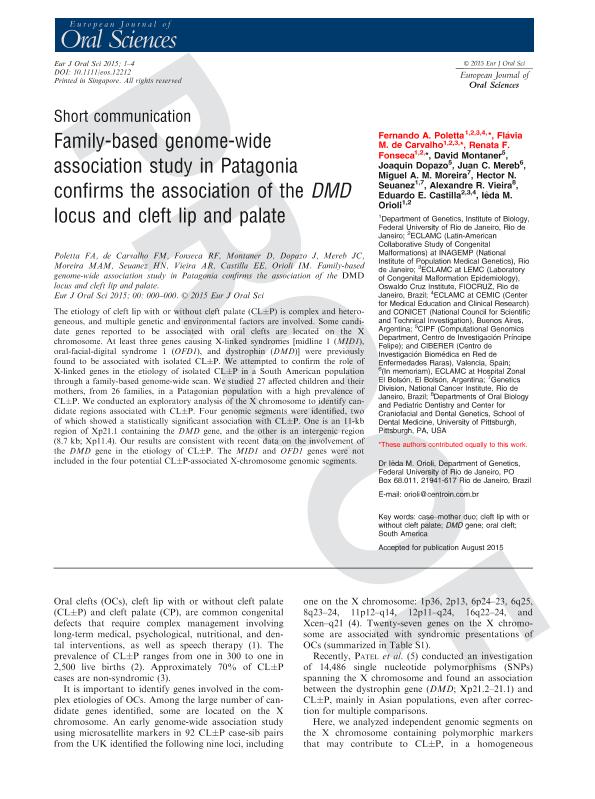Artículo
Family-based genome-wide association study in Patagonia confirms the association of the DMD locus and cleft lip and palate
Fonseca, Renata F.; de Carvalho, Flávia M.; Poletta, Fernando Adrián ; Montaner, David; Dopazo, Joaquin; Mereb, Juan C.; Moreira, Miguel A. M.; Seuanez, Hector N.; Vieira, Alexandre R.; Castilla, Eduardo Enrique
; Montaner, David; Dopazo, Joaquin; Mereb, Juan C.; Moreira, Miguel A. M.; Seuanez, Hector N.; Vieira, Alexandre R.; Castilla, Eduardo Enrique ; Orioli, Iêda M.
; Orioli, Iêda M.
 ; Montaner, David; Dopazo, Joaquin; Mereb, Juan C.; Moreira, Miguel A. M.; Seuanez, Hector N.; Vieira, Alexandre R.; Castilla, Eduardo Enrique
; Montaner, David; Dopazo, Joaquin; Mereb, Juan C.; Moreira, Miguel A. M.; Seuanez, Hector N.; Vieira, Alexandre R.; Castilla, Eduardo Enrique ; Orioli, Iêda M.
; Orioli, Iêda M.
Fecha de publicación:
10/2015
Editorial:
Wiley Blackwell Publishing, Inc
Revista:
European Journal Of Oral Sciences
ISSN:
0909-8836
Idioma:
Inglés
Tipo de recurso:
Artículo publicado
Clasificación temática:
Resumen
The etiology of cleft lip with or without cleft palate (CL±P) is complex and heterogeneous, and multiple genetic and environmental factors are involved. Some candidate genes reported to be associated with oral clefts are located on the X chromosome. At least three genes causing X‐linked syndromes [midline 1 (MID1), oral‐facial‐digital syndrome 1 (OFD1), and dystrophin (DMD)] were previously found to be associated with isolated CL±P. We attempted to confirm the role of X‐linked genes in the etiology of isolated CL±P in a South American population through a family‐based genome‐wide scan. We studied 27 affected children and their mothers, from 26 families, in a Patagonian population with a high prevalence of CL±P. We conducted an exploratory analysis of the X chromosome to identify candidate regions associated with CL±P. Four genomic segments were identified, two of which showed a statistically significant association with CL±P. One is an 11‐kb region of Xp21.1 containing the DMD gene, and the other is an intergenic region (8.7 kb; Xp11.4). Our results are consistent with recent data on the involvement of the DMD gene in the etiology of CL±P. The MID1 and OFD1 genes were not included in the four potential CL±P‐associated X‐chromosome genomic segments.
Palabras clave:
Cleft Lip/Palate
,
X Chromosome
,
Microarray
,
Dmd Gene
Archivos asociados
Licencia
Identificadores
Colecciones
Articulos(SEDE CENTRAL)
Articulos de SEDE CENTRAL
Articulos de SEDE CENTRAL
Citación
Fonseca, Renata F.; de Carvalho, Flávia M.; Poletta, Fernando Adrián; Montaner, David; Dopazo, Joaquin; et al.; Family-based genome-wide association study in Patagonia confirms the association of the DMD locus and cleft lip and palate; Wiley Blackwell Publishing, Inc; European Journal Of Oral Sciences; 123; 5; 10-2015; 381-384
Compartir
Altmétricas



